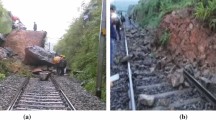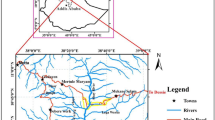Abstract
Kharsali village, located in the Northwest Himalaya near the confluence of the Yamuna River and Unta Gad, is situated on a thick (>150 m) paleolandslide deposit. The village is continuously being eroded at its base by the two rivers. Cracks are noted in most houses while the ancient Shani Temple lying to the south of the village has tilted ~5° towards the northeast. Three slope sections (S-1, S-2, S-3) were modelled and analysed to determine the displacement and shear strain patterns of the slopes. Based on surface failure conditions, potential slope instability of the Kharsali village was evaluated from 2D Finite Element Method (FEM) using Shear Strain Reduction (SSR) analysis in the Phase2 software. Results indicate a critical Stress Reduction Factor (SRF) of 1.5 for the southern edge of the village (S-1) housing the Shani Temple. The development of failure surfaces at its lower portion signifies the propagating, progressive nature of the slope. The S-2 slope section is most vulnerable to slope failure, with a critical SRF of 1.08. This has been inferred by the formation of failure surfaces with displacements of 0.05–0.08 m. The S-3 section in the northern part of the Kharsali shows highest critical SRF of 2.76. The un-metalled road section in the north of the village near S-3 has developed a failure surface with displacement of 0.003–0.004 m, and a zone of subsidence. The S-3 section is relatively stable, whereas the S-2 section is the most vulnerable portion of the village.
Similar content being viewed by others
References
Agarwal NC, Kumar G (1973) Geology of the upper Bhagirathi and Yamuna valleys, Uttarkashi district, Kumaun Himalaya. Himalayan Geology 3: 2–23.
Alemdag S, Akgun A, Kaya A et al. (2014) A large and rapid planar failure: causes, mechanism, and consequences (Mordut, Gumushane, Turkey). Arabian Journal of Geosciences 7(3): 1205–1221. DOI: 10.1007/s12517-012-0821-1
Anbalagan R (1992) Landslide hazard evaluation and zonation map** in mountainous terrain. Engineering geology 32(4): 269–277. DOI: 10.1016/0013-7952(92)90053-2
Barnard PL, Owen LA, Sharma MC et al. (2001) Natural and human-induced landsliding in the Garhwal Himalaya of northern India. Geomorphology 40(1): 21–35. DOI: 10.1016/S0169-555X (01)00035-6
Biyani AK (1995) Structural and metamorphic history of Higher Himalayan Zone of Phulchatti to Yamunotri area, with special reference to Main Central Thrust in Garhwal Himalaya. Unpublished D. Phil, thesis, HNB Garhwal University, Srinagar.
Bowles JE (1996) Foundation Analysis and Design (5th Edition) McGraw-Hill. p 750.
Census of India (2011) Ministry of Home Affairs, Govt. of India, New Delhi.
Fredlund DG, Krahn J (1977) Comparison of slope stability methods of analysis. Canadian Geotechnical Journal 14(3): 429–439. DOI: 10.1139/t77-045
Griffiths DV, Lane PA (1999) Slope stability analysis by finite elements. Geotechnique 49(3): 387–403.
Gupta V, Bhasin RK, Kaynia AM, et al. (2016a) Finite element analysis of failed slope by shear strength reduction technique: a case study for Surabhi Resort Landslide, Mussoorie Township, Garhwal Himalaya. Geomatics, Natural Hazards and Risk 7(5): 1677–1690. DOI: 10.1080/19475705.2015.1102778
Gupta V, Nautiyal H, Kumar V, et al. (2016b) Landslides hazards around Uttarkashi Township, Garhwal Himalaya, after the tragic flash flood in June 2013. Natural Hazards 80: 1689–1707. DOI: 10.1007/s11069-015-2048-4
Gupta V, Sah MP (2008) Spatial Variability of Mass Movements in the Satluj Valley, Himachal Pradesh during 1990-2006. Journal of Mountain Science 5: 38–51. DOI: 10.1007/s11629-008-0038-7
Gurocak Z, Alemdag S, Zaman MM (2008) Rock slope stability and excavatability assessment of rocks at the Kapikaya dam site, Turkey. Engineering Geology 96(1): 17–27. DOI: 10.1016/j.enggeo.2007.08.005
Jibson RW (2011) Methods for assessing the stability of slopes during earthquakes—A retrospective. Engineering Geology 122(1): 43–50. DOI: 10.1016/j.enggeo.2010.09.017
**g L (2003) A review of techniques, advance and outstanding issues in numerical modelling for rock mechanics and rock engineering. International Journal of Rock Mechanics and Mineral Science 40: 283–353. DOI: 10.1016/S1365-1609 (03)00013-3
Kanungo DP, Pain A, Sharma S (2013) Finite element modelling approach to assess thestability of debris and rock slopes: a case study from the Indian Himalayas. Natural hazards 69(1): 1–24. DOI: 10.1007/s11069-013-0680-4
Kaya A, Alemdağ S, Dağ S, et al. (2016) Stability assessment of high-steep cut slope debris on a landslide (Gumushane, NE Turkey). Bulletin of Engineering Geology and the Environment 75(1): 89–99. DOI: 10.1007/s10064-015-0753-6
Kumar G (2005) Geology of Uttar Pradesh and Uttaranchal. Geological Society of India Bangalore (1st Edition), India.
Liu SY, Shao LT, Li HJ (2015) Slope stability analysis using the limit equilibrium method and two finite element methods. Computers and Geotechnics 63: 291–298. DOI: 10.1016/j.compgeo.2014.10.008
Martha TR, Roy P, Govindharaj KB, et al. (2015) Landslides triggered by the June 2013 extreme rainfall event in parts of Uttarakhand state, India. Landslides 12: 135–146. DOI: 10.1007/s10346-014-0540-7
Matsui T, San KC (1992) Finite element slope stability analysis by shear strength reduction technique. Soils and Foundation 32(1): 59–70. DOI: 10.3208/sandf1972.32.59
Nian TK, Chen GQ, Wan SS, et al. (2011) Non-convergence Criterion on Slope Stability FE Analysis by Strength Reduction Method. Journal of Convergence Information Technology 6: 78–88. DOI: 10.4156/jcit.vo16.issue5.9
Parkash S, Kathait A (2014) A selected annotated bibliography and bibliography on landslides in India. National Institute of Disaster Management, Ministry of Home Affairs, Govt. of India, New Delhi, p 172.
Paul SK, Bartarya SK, Rautela P, et al. (2000) Catastrophic mass movement of 1998 monsoons at Malpa in Kali Valley, Kumaun Himalaya (India). Geomorphology 35(3): 169–180. DOI: 10.1016/S0169-555X (00)00032-5
Paul A, Kumar N (2010) Estimates of source parameters of M4. 9 Kharsali earthquake using waveform modelling. Journal of Earth System Science 119(5): 731–743. DOI: 10.1007/s12040-010-0050-5
PHASE2 v.6.024 (2007) 2D elasto-plastic finite element stress analysis program for underground or surface excavations in rock or soil. Rocscience Inc. Canada.
Rahardjo H, Lee TT, Leong E, et al. (2005) Response of a residual soil slope to rainfall. Canadian Geotechnical Journal 42(2): 340–351. DOI: 10.1139/T04-101
Rautela P, Joshi GC, Singh Y, et al. (2008) Housing Report: Timber-reinforced stone masonry (Koti banal architecture) of Uttarakhand and Himachal Pradesh, Northern India. World Housing Encyclopedia Report no. 150
Roscoe KH (1970) The influence of strains in soil mechanics, Tenth Rankine Lecture. Geotechnique 20: 129–170. DOI: 10.1680/geot.1970.20.2.129
Sanwal R, Jaiswal P, Baruah MK (2005) Landslide zonation map** in Yamuna basin, Dehradun, Uttarkashi Tehri–Garhwal and Chamoli districts, Uttaranchal (phase-ii). Geological Society of India (Field season: 2003-04 and 2004-05), Unpublished.
Saran S, Ranjan G, Singh B, et al. (1984) Damage and remedial measures for buildings on hill slopes. 1st International conference on case histories in geotechnical engineering. Missouri University of Science and Technology, USA Paper 53.
Sarkar S, Kanungo DP, Kumar S (2012) Rock mass classification and slope stability assessment of road cut slopes in Garhwal Himalaya, India. Geotechnical and Geological Engineering 30(4): 827–840. DOI: 10.1007/s10706-012-9501-x
Shaorui S, Penglei X, Jimin W, et al. (2014) Strength parameter identification and application of soil–rock mixture for steepwalled talus slopes in southwestern China. Bulletin of Engineering Geology and the Environment 73(1): 123–140. DOI: 10.1007/s10064-013-0524-1
Standard-IS: 1498–1970 (Reaffirmed 2007). Classification and identification of soils for general engineering purposes. New Delhi, India.
Standard-IS: 2720 (Part 10)–1991. Method of test for soils: Unconfined Compressive Strength, New Delhi, India.
Standard-IS: 2720 (Part 13)–1986. Method of test for soils: Direct shear test, New Delhi, India.
Standard-IS: 2720 (Part 4)–1985. Methods of test for soils: Determination of grain size analysis of soil, New Delhi, India.
Talobre JA (1967) Rock mechanics and its application. Dunod, Paris. p 442. (In French)
Tiwari G, Latha GM (2016) Design of Rock Slope Reinforcement: A Himalayan Case Study. Rock Mechanics and Rock Engineering 49: 2075–2097. DOI: 10.1007/s00603-016-0913-4
Online Submission and Monitoring of Environmental Clearance, Ministry of Environment, Forest and Climate Change, Government of India. Available online: http://environmentclearance.nic.in/writereaddata/modification/PreviousTOR/0_0_29092014ZM36AAnnexure—ANNEXUREIandII.pdf (Accessed on 20 December 2016)
Xu J (2011) Debris slope stability analysis using threedimensional finite element method based on maximum shear stress theory. Environmental Earth Sciences 64(8): 2215–2222. DOI: 10.1007/s12665-011-1049-1
Zienkiewicz OC, Humpheson C, Lewis RW (1975) Associated and non-associated visco-plasticity and plasticity in soil mechanics. Géotechnique 25 (4): 671–89. DOI: 10.1680/geot.1977.27.1.101
Acknowledgement
The authors thank Prof. Anil Kumar Gupta, Director, Wadia Institute of Himalayan Geology, Dehradun for providing the facilities to carry out the work. The authors are also thankful for the geotechnical analysis at the National Geotechnical Facility, Dehradun. The grant from the Department of Science and Technology (DST) NRDMS/11/3066/2014(G) for carrying out this research is also acknowledged. This work forms a part of the doctoral thesis of Imlirenla Jamir; She sincerely acknowledges the INSPIRE fellowship from the DST. The Reviewers are thanked for their comments and suggestions which helped to improve the quality of the manuscript.
Author information
Authors and Affiliations
Corresponding author
Rights and permissions
About this article
Cite this article
Jamir, I., Gupta, V., Kumar, V. et al. Evaluation of potential surface instability using finite element method in Kharsali Village, Yamuna Valley, Northwest Himalaya. J. Mt. Sci. 14, 1666–1676 (2017). https://doi.org/10.1007/s11629-017-4410-3
Received:
Revised:
Accepted:
Published:
Issue Date:
DOI: https://doi.org/10.1007/s11629-017-4410-3




